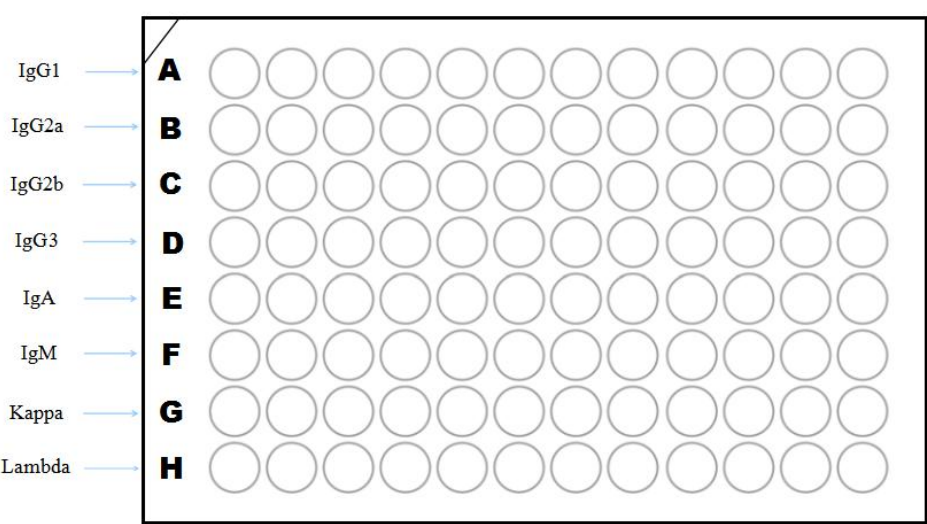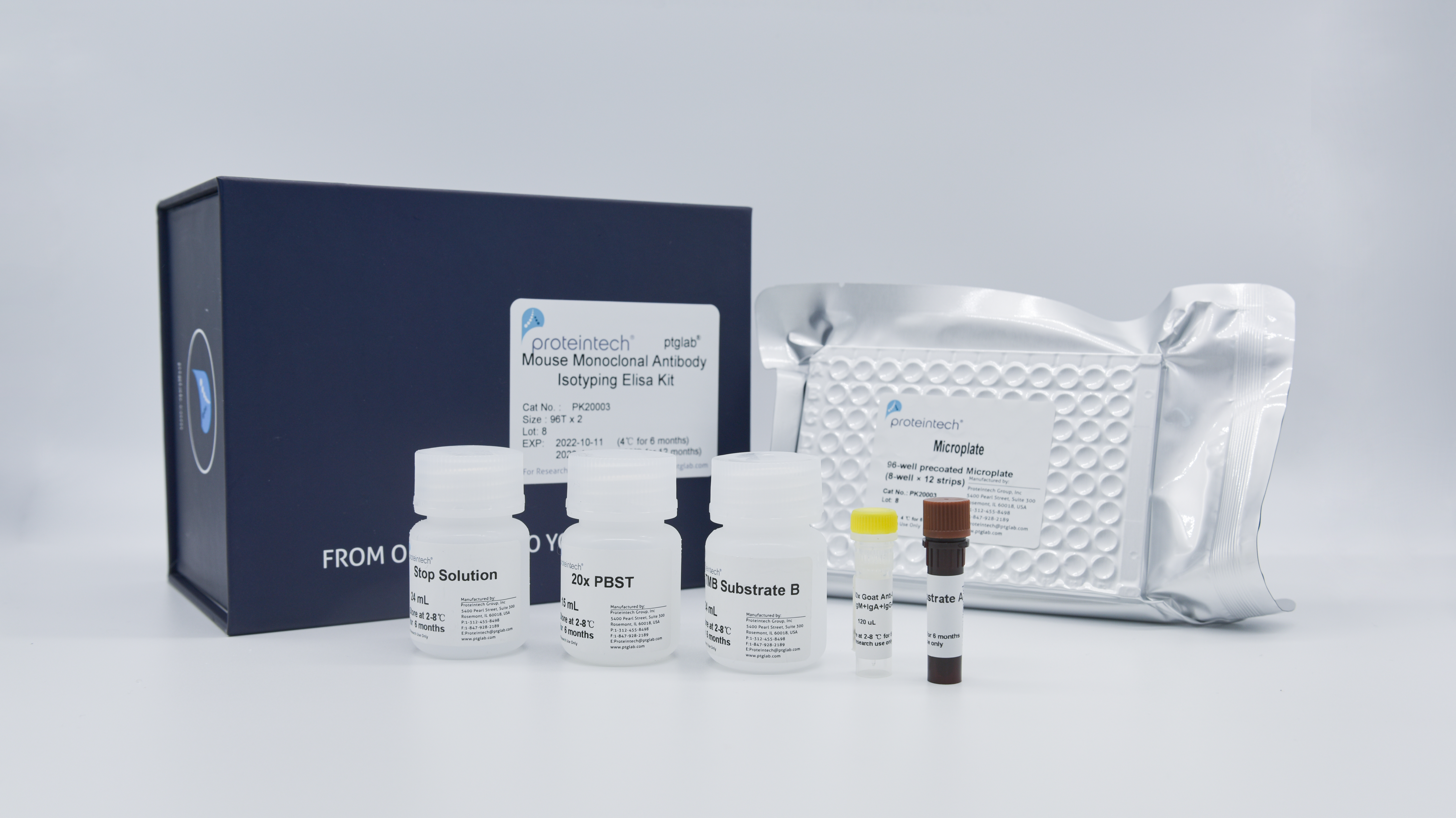Validation Data Gallery
产品介绍
| Catalog No. PK20003 | 2*96孔 | 5*96孔 |
| 酶标板(Microplate)预包被了针对小鼠 IgG1,IgG2a,IgG2b,IgG3,IgA,IgM,kappa light chain,lambda light chain 的特异性抗体 | 2 块 | 5 块 |
| 封板膜(Plate Cover seals) | 2 张 | 5 张 |
| 20× PBST | 15 mL | 20 mL × 2 |
| 100× 羊抗鼠 IgA+IgM+IgG-HRP(Goat Anti-Mouse IgA+IgM+IgG-HRP) | 120 uL | 300 uL |
| 显色液(TMB Substrate)A 液 | 240 uL | 600 uL |
| 显色液(TMB Substrate)B 液 | 24 mL | 30 mL × 2 |
| 终止液(Stop Solution) | 24 mL | 30 mL × 2 |
保存条件
该试剂盒在低温下运输,在未开封情况下,4°C保存6个月 或者 -20°C保存12个月,开封之后,1周内用完。
使用方法
1. 材料准备
从 4°C 中取出 Mouse 单克隆抗体亚型鉴定试剂盒,室温条件下平衡 30 分钟。
a. 1×PBST : 10 mL 20×PBST + 190 mL 超纯水
b. 酶标板条 : 根据样本数量选取酶标板条数(测定 1 个样本需要 1 条酶标板条),余下板条置于密封 袋中,4°C 保存。
c. 1×IgA+IgM+IgG-HRP : 10 uL 100×羊抗鼠 IgA+IgM+IgG-HRP + 990 uL 1×PBST
2. 样本准备
a. 杂交瘤细胞上清 : 将样本以 1× PBST 1:100 稀释,例如 10 uL 杂交瘤细胞上清 + 990 uL 1×PBST。推荐稀 释范围为 1:20-1:200。
b. 腹水 : 将样本以 1×PBST 1:100000 稀释,例如 1 uL 腹水 + 1 mL 1×PBST(1:1000),再取上 述混合液 5 uL + 495 uL 1× PBST。推荐稀释范围为 1:50000-1:200000。
c. 纯化抗体 : 将样本以 1×PBST 稀释至 200 ng/mL,推荐稀释浓度为 20 ng/mL-1 ug/mL。
3. 单克隆抗体亚型鉴定
a. 将待测样本适当稀释加入板条样品孔中,50 uL/孔。
b. 无需孵育,将 1×羊抗鼠 IgA+IgM+IgG-HRP 加入样品孔中,50 uL/孔。混匀器上轻轻混匀,也可用手轻轻敲击板架两侧 1 min。
c. 盖上封板膜,室温孵育 1 h。
d. 弃去孔内液体,1×PBST 洗板 3 次,吸水纸上拍干。
e. 将现配的显色液加入孔中,100 uL/孔。
注:显色液配方,A 液:B 液=1:100,即 10 uL A 液与 1 mL B 液混合,混匀后立即使用。
f. 室温避光显色 10-20 min。每孔加入终止液,100 uL/孔。
g. 结果判读。结果可以对照下图以肉眼判定,也可以通过酶标仪读取 OD450。颜色最深或是 OD 值最高孔对应的即为相应亚型。
注:每个样本应该在 A-F 中有一个阳性孔(即是样本重链类型),G 和 H 中有一个阳性孔(即是样本轻链类型)。

注意
1. 显色液应临用前配制,即配即用。显色液 A 液应避光保存。
2. 余下板条应密封保存。如短期不用,可置于-20°C 保存。
常见问题及解答:
| 常见问题 | 可能原因 | 解决方案 |
| 多种重链结果 | 腹水中有杂抗体 | 将腹水样本至少 1:100000 稀释 |
| 样本中抗体浓度过高 | 再将样本 1:2-1:10 稀释 | |
| 杂交瘤细胞中含有多种细胞系 | 亚克隆杂交瘤细胞 | |
| 显色较慢或颜色较弱 | 样本中抗体浓度低 | 减少稀释倍数;延长显色时间 |
| 结果难以判定 | 多种重链或轻链结果 | 再将样本 1:4 或 1:8 稀释后重新检测 |
Publications
| Application | Title |
|---|---|
Cancer Lett MMGZ01, an anti-DLL4 monoclonal antibody, promotes nonfunctional vessels and inhibits breast tumor growth. | |
J Agric Food Chem Development and validation of an indirect competitive enzyme-linked immunosorbent assay for the screening of tylosin and tilmicosin in muscle, liver, milk, honey and eggs. | |
ACS Infect Dis Intranasal Delivery of Antigen-Coated Polymer Particles Protects against Pseudomonas aeruginosa Infection. | |
Biosensors (Basel) A Magnetic-Bead-Based Immunoassay with a Newly Developed Monoclonal Antibody for Rapid and Highly Sensitive Detection of Forchlorfenuron | |
Int J Biol Macromol Precise location of two novel linear epitopes on the receptor-binding domain surface of MERS-CoV spike protein recognized by two different monoclonal antibodies. | |
Int J Biol Macromol Development and characterization of recombinant ASFV CD2v protein nanoparticle-induced monoclonal antibody. |


